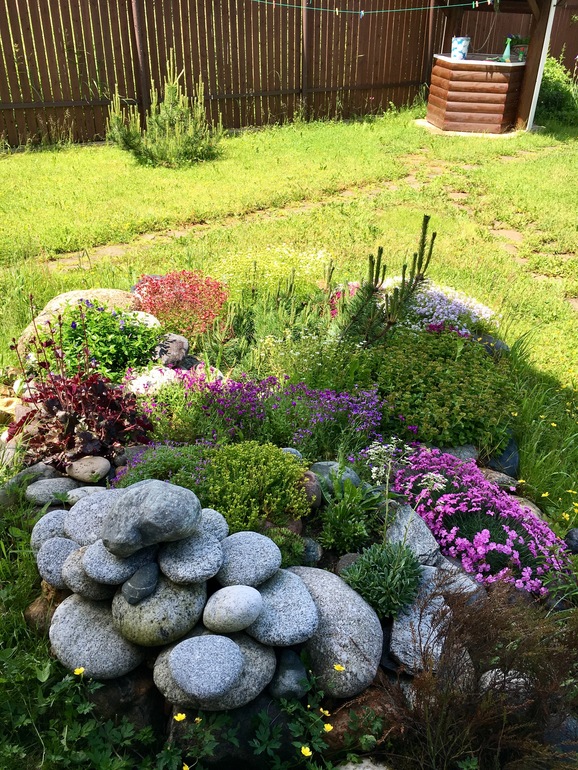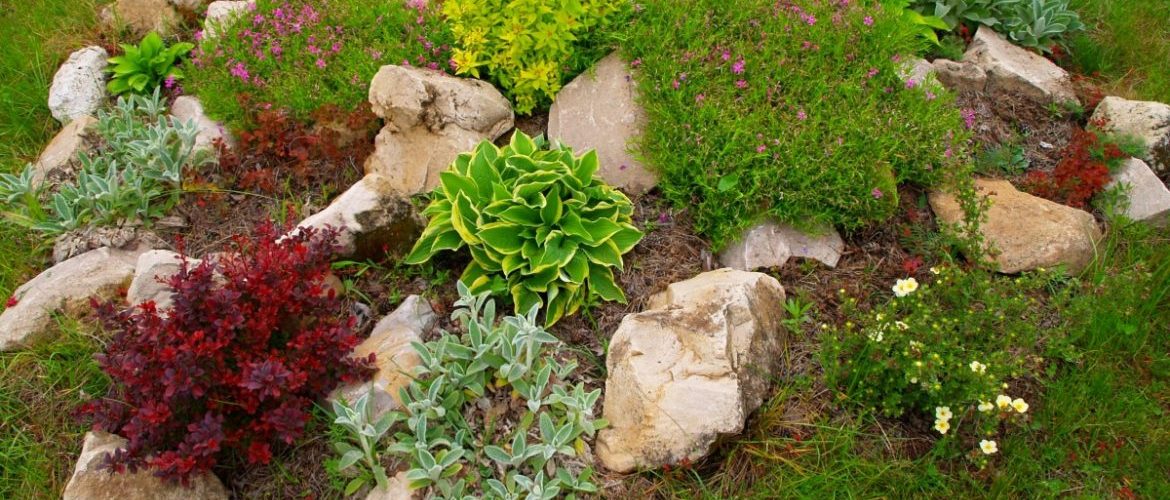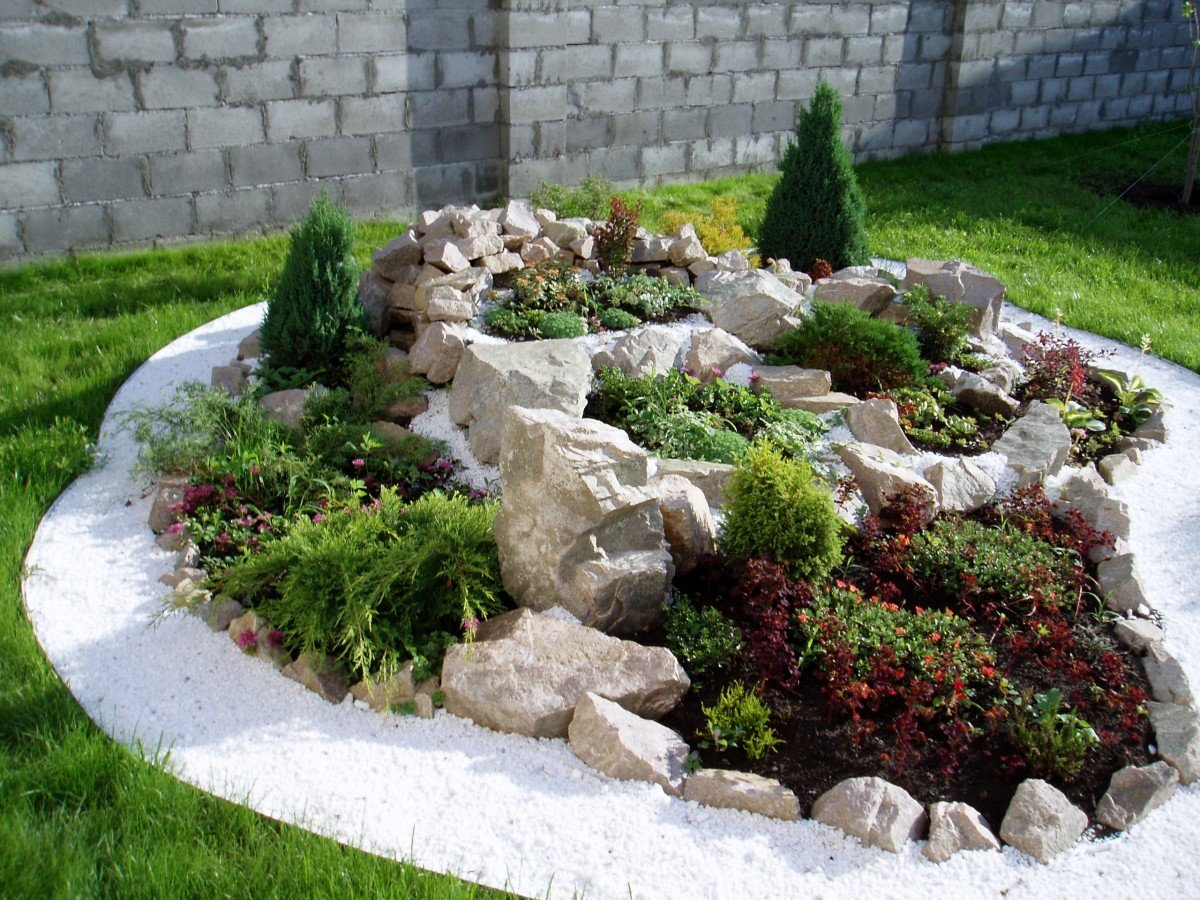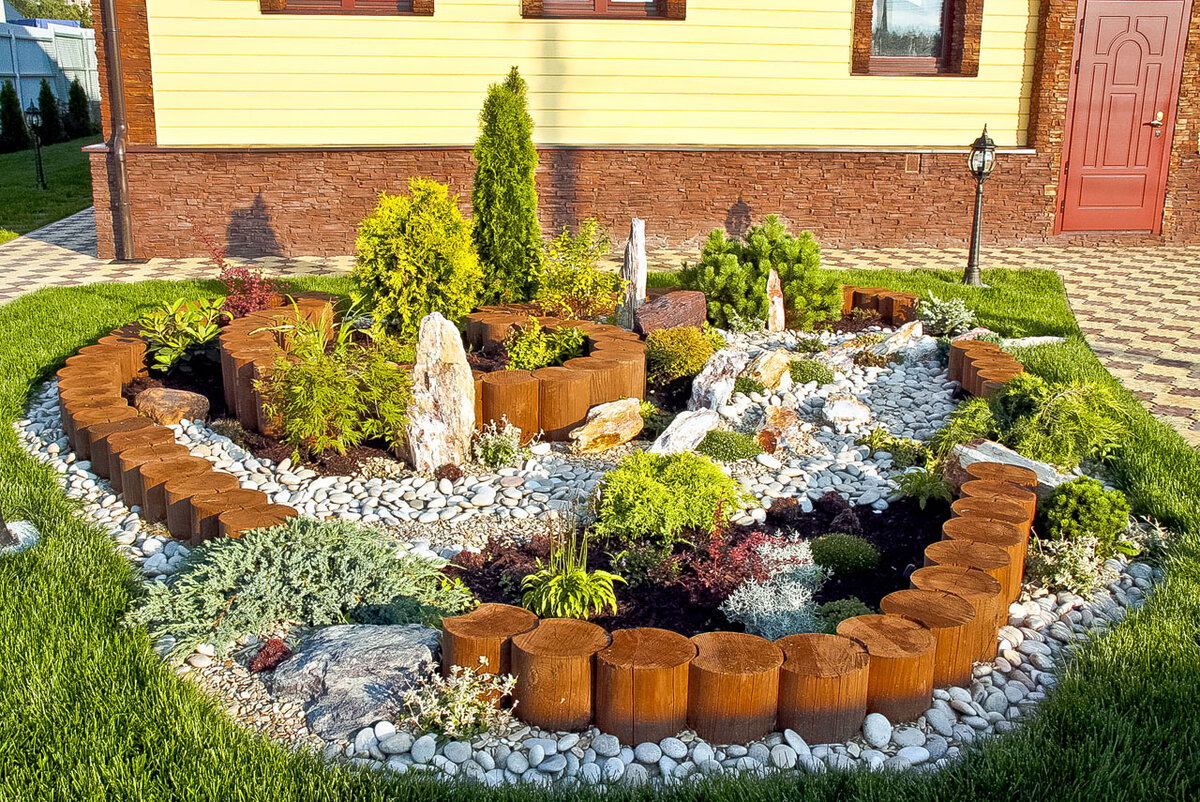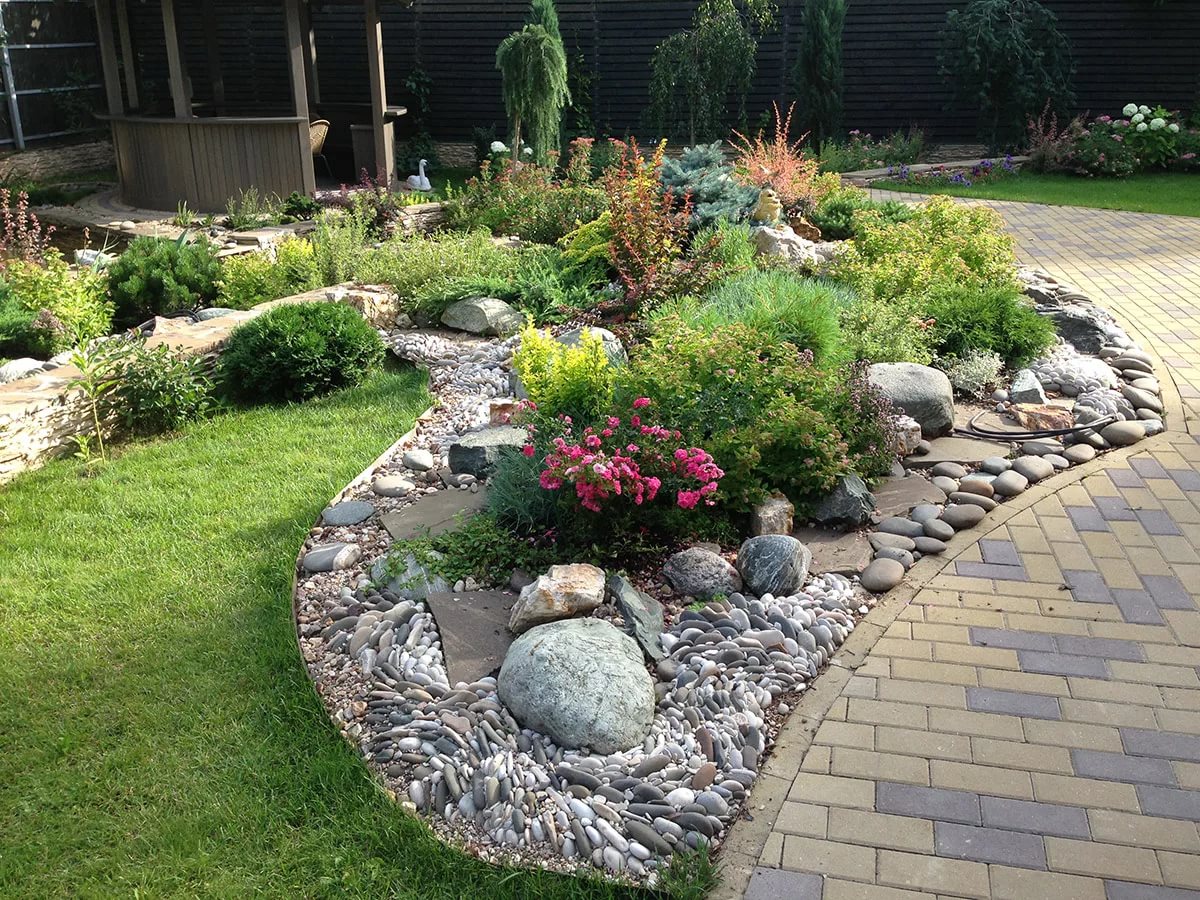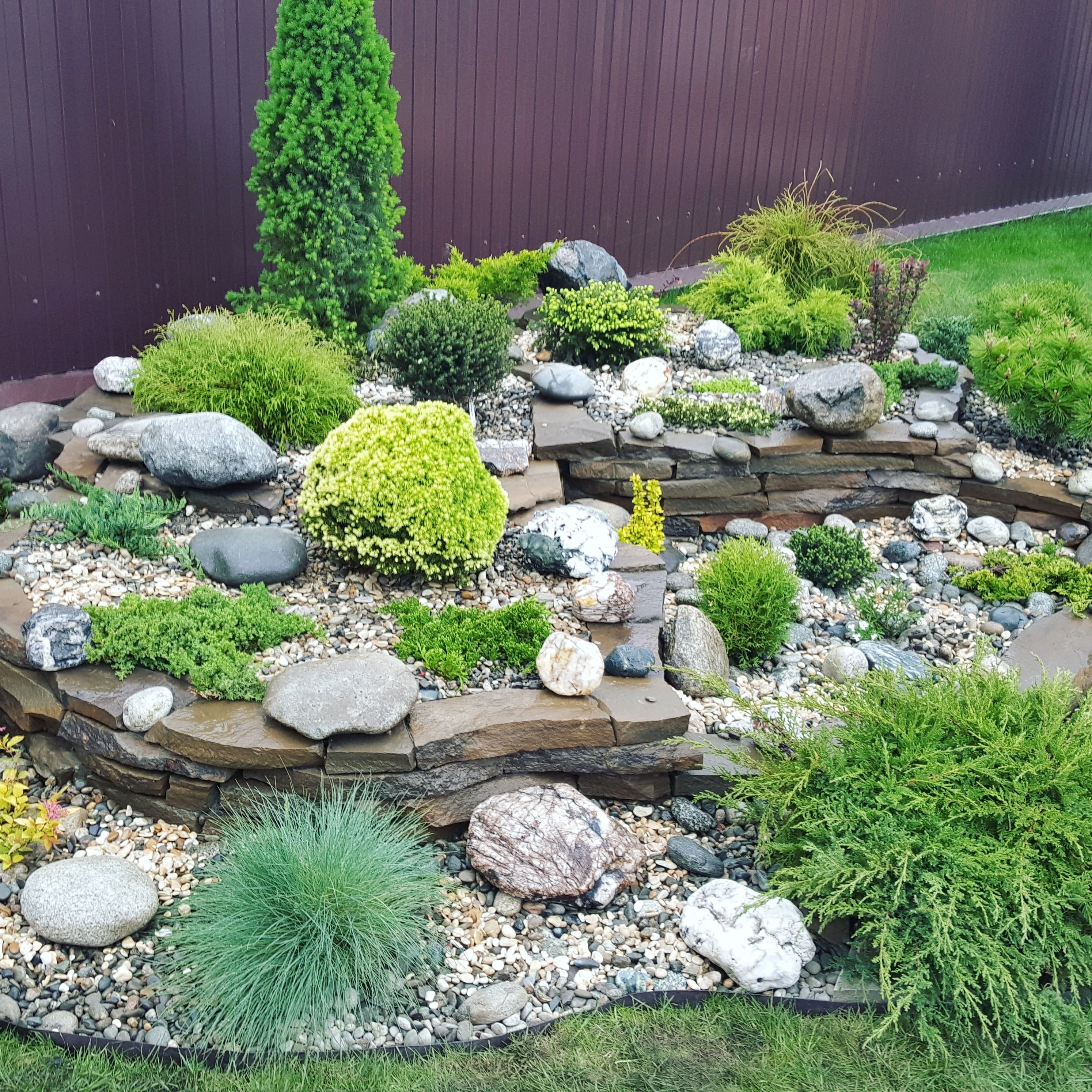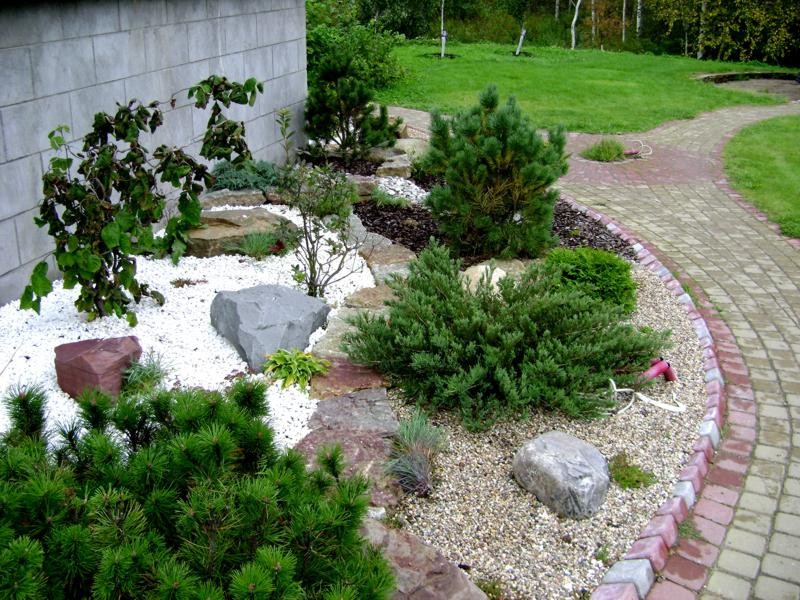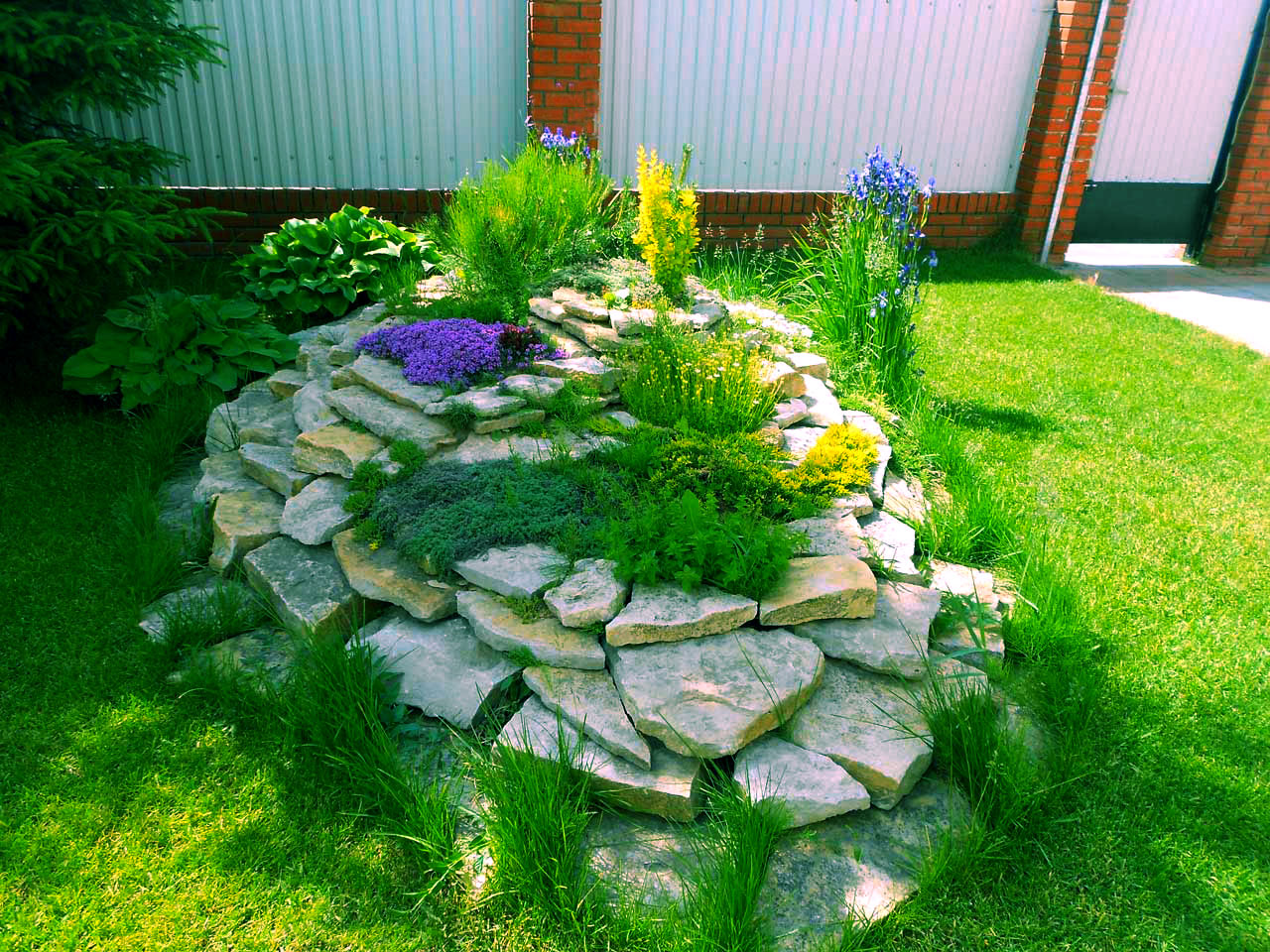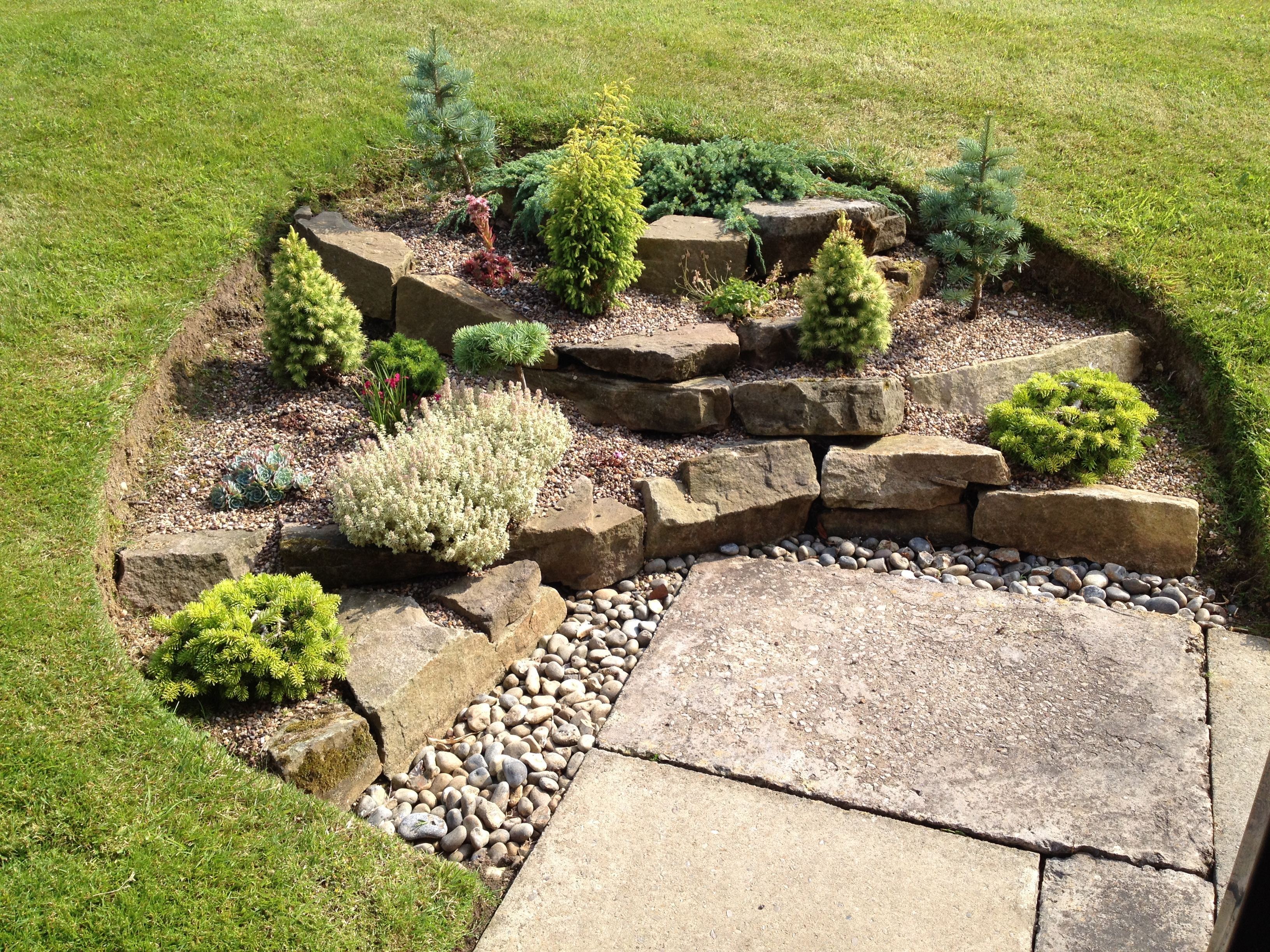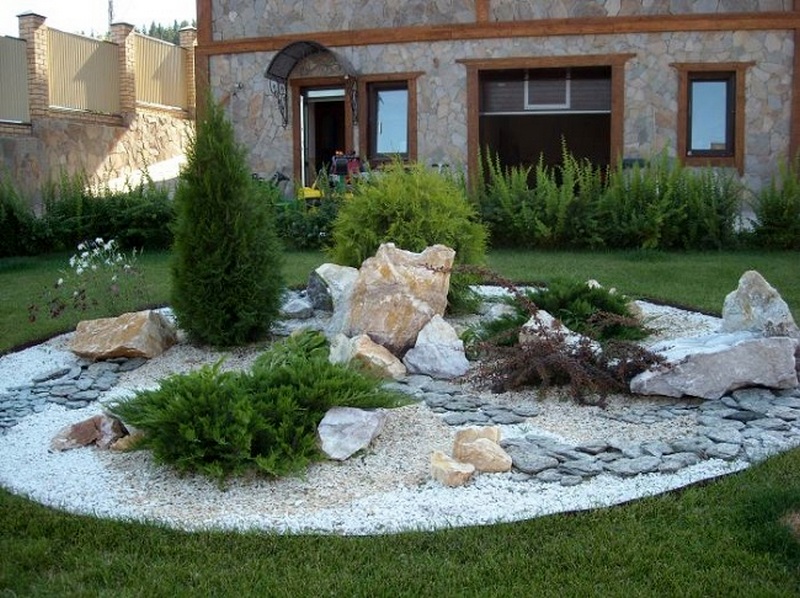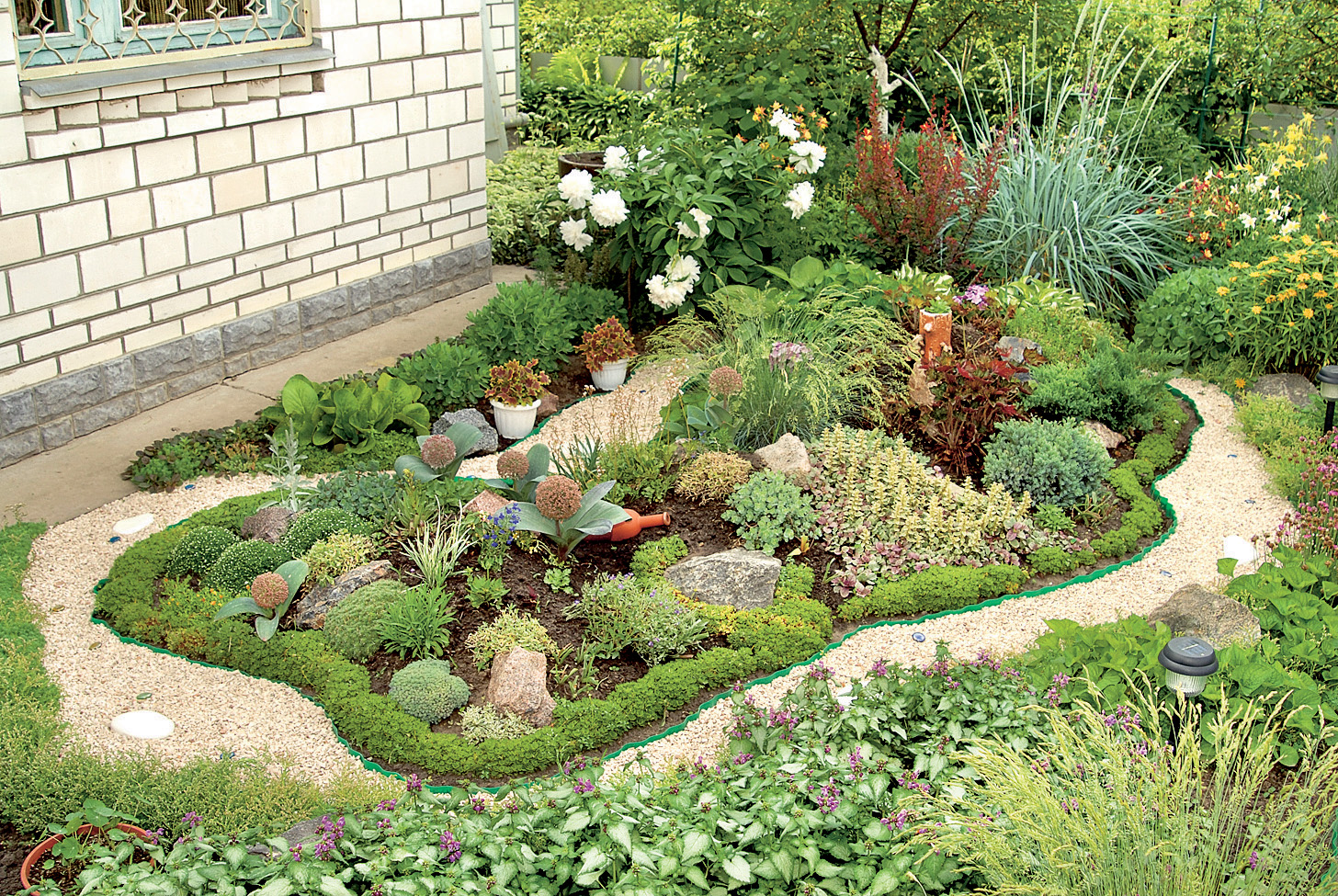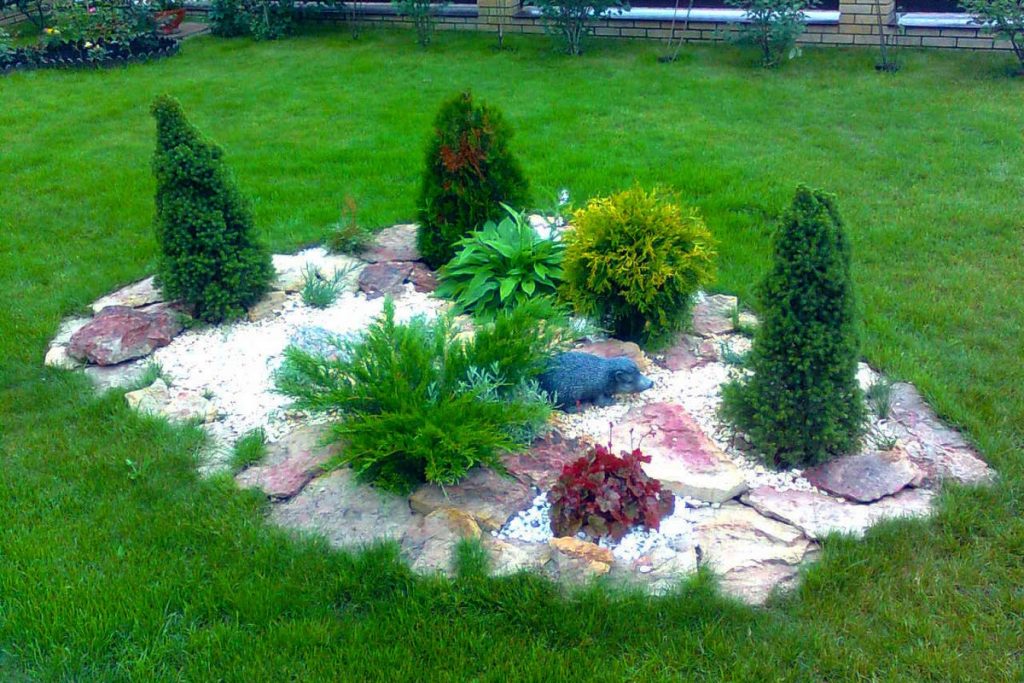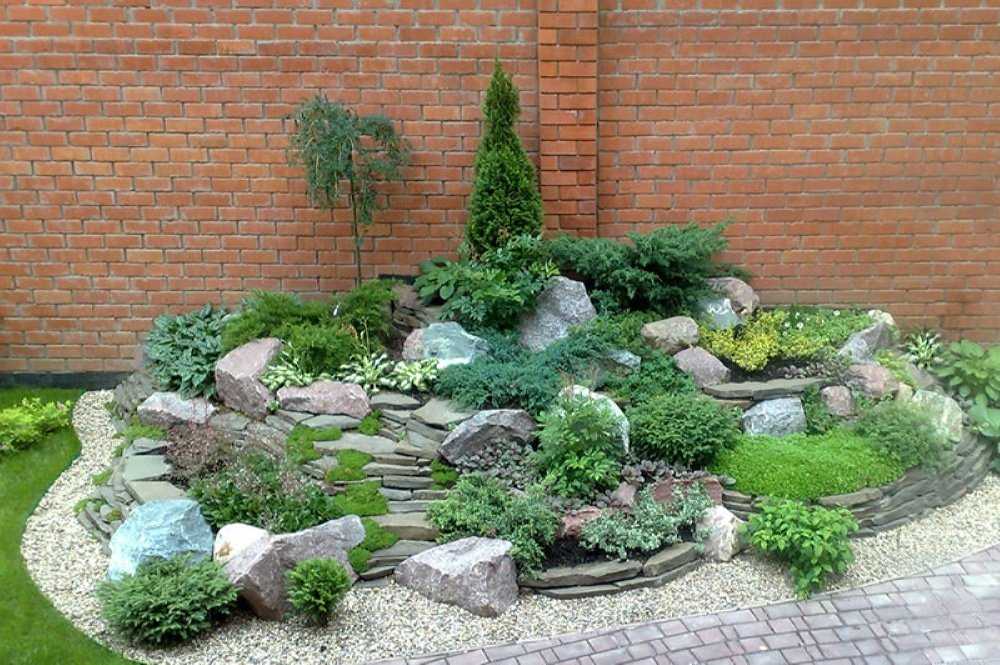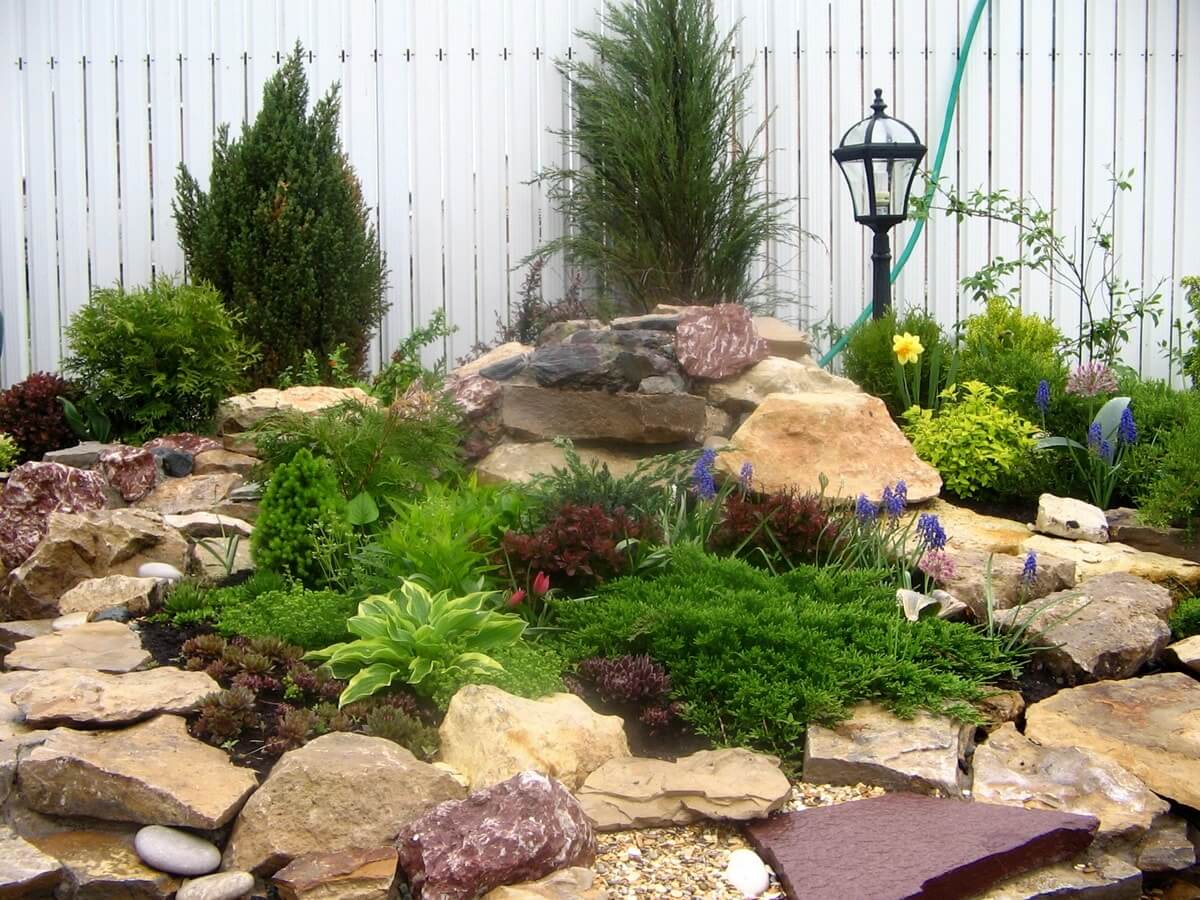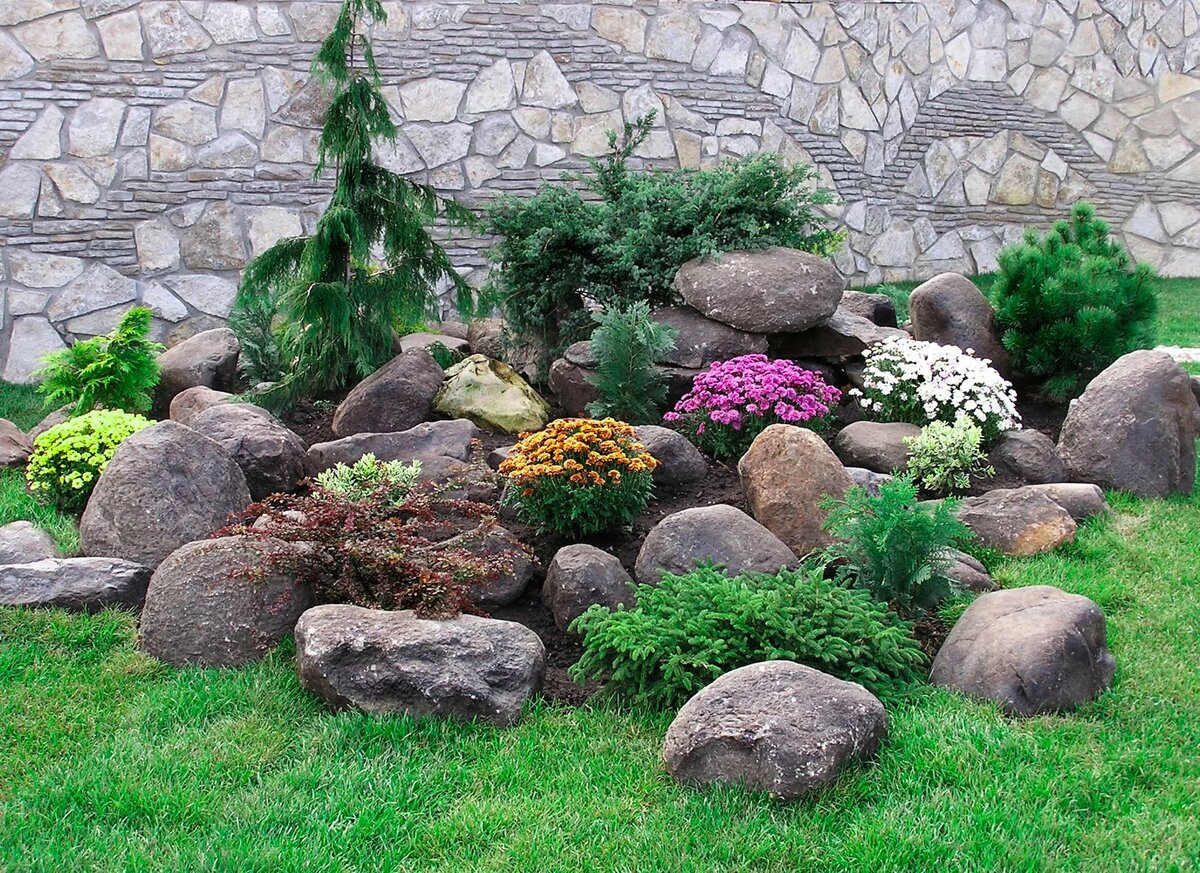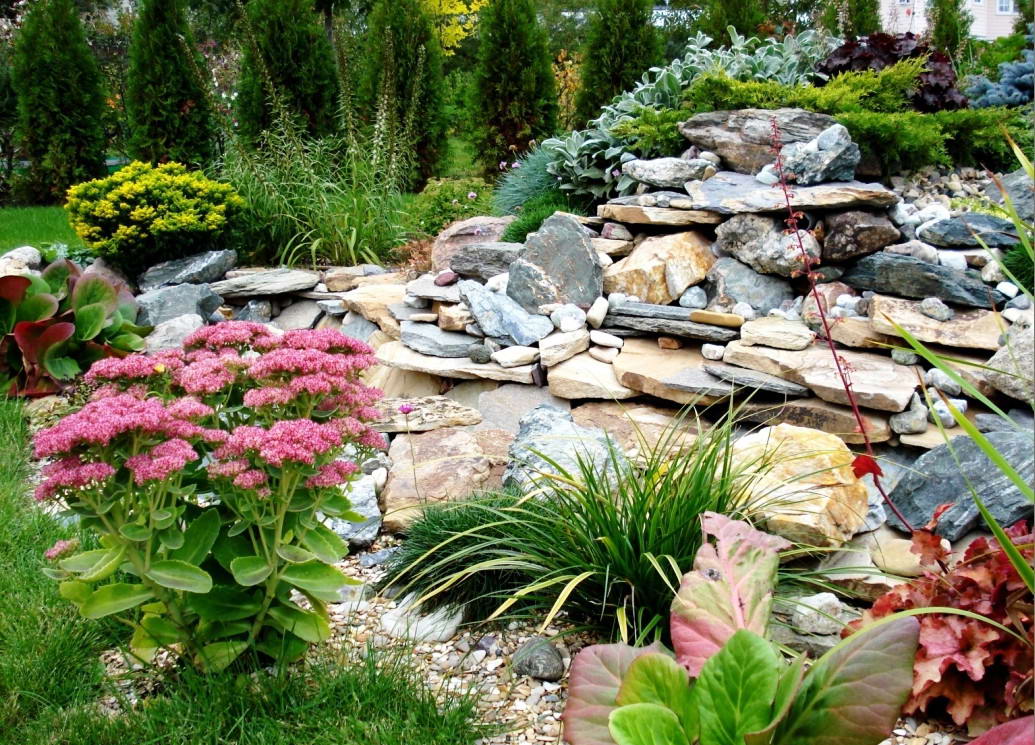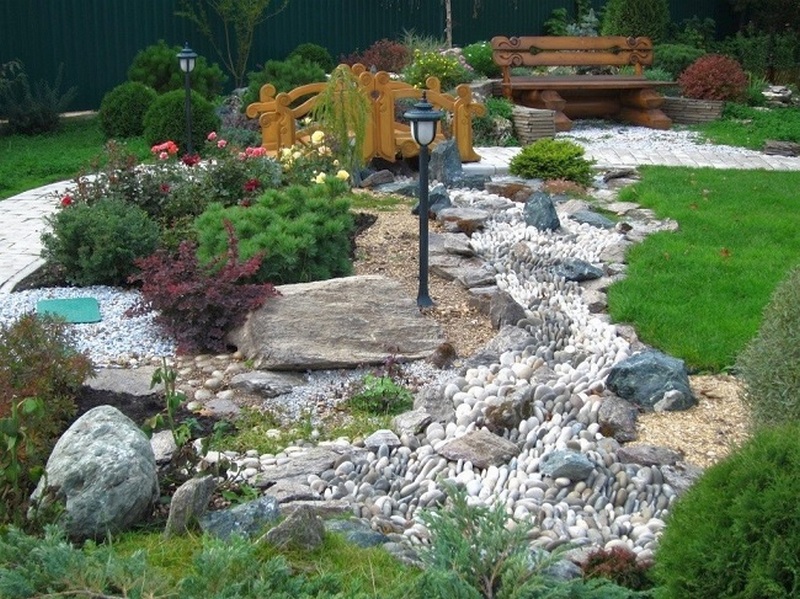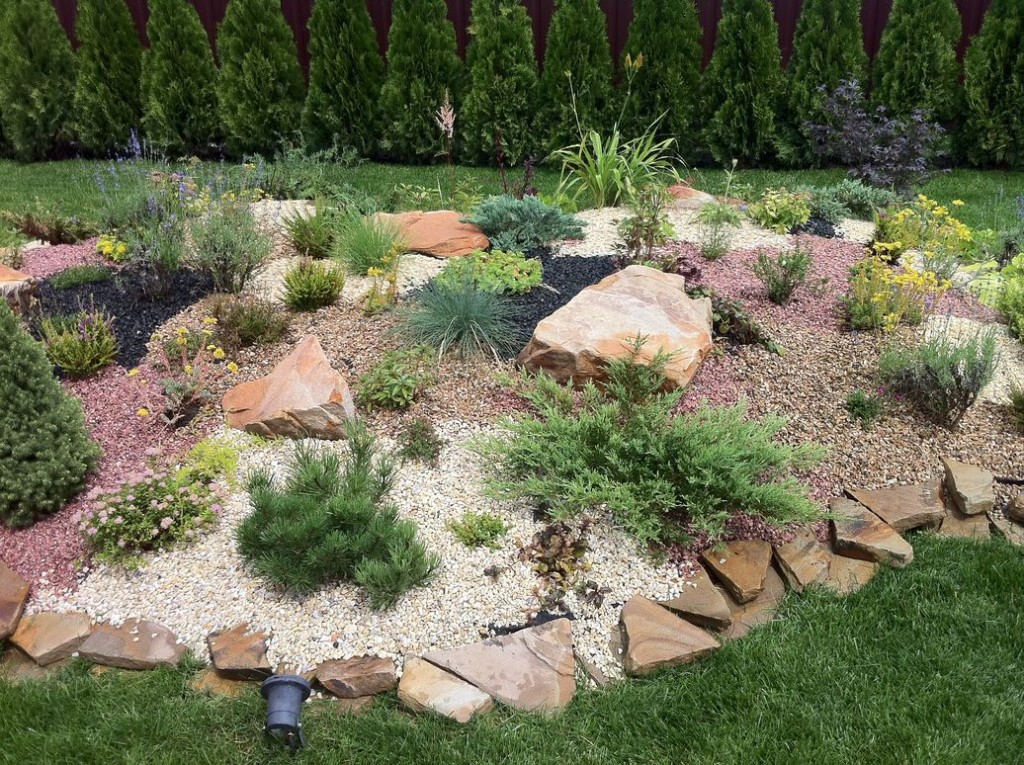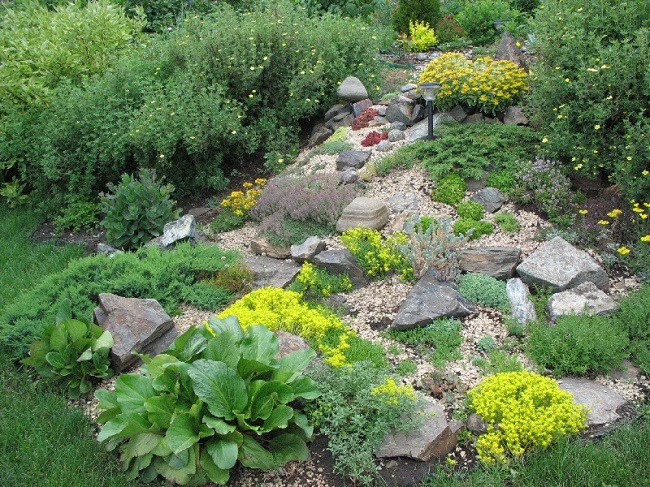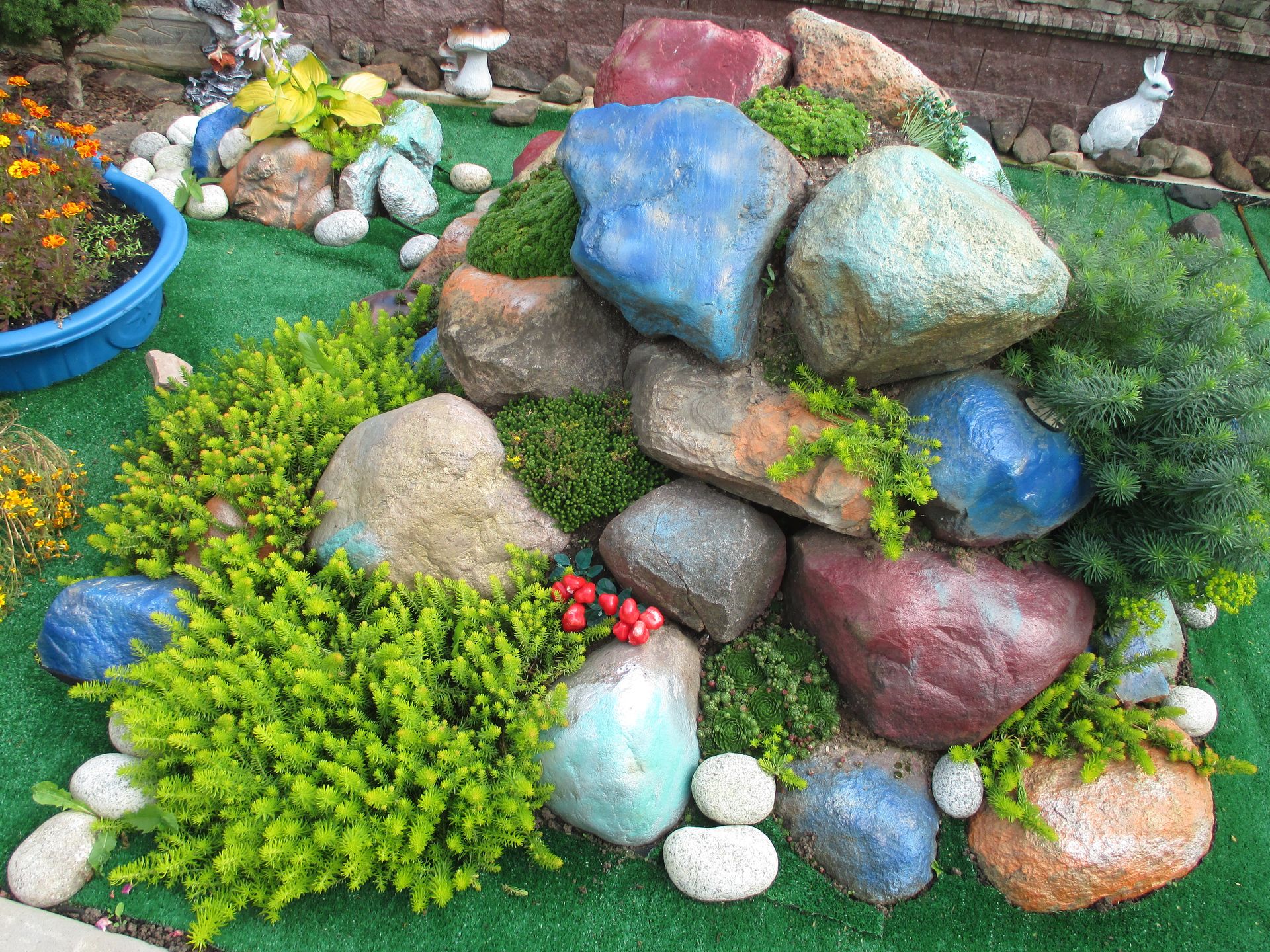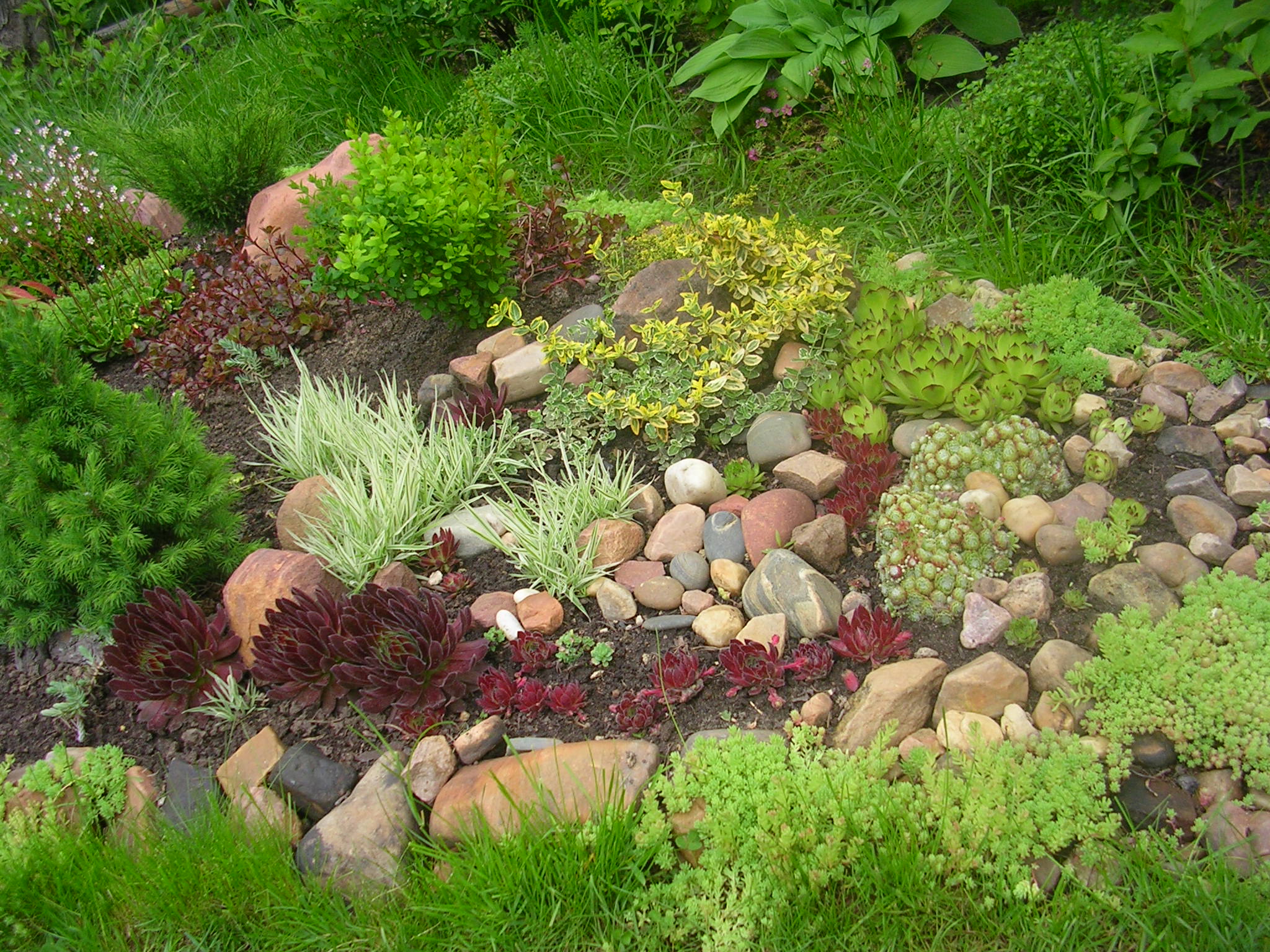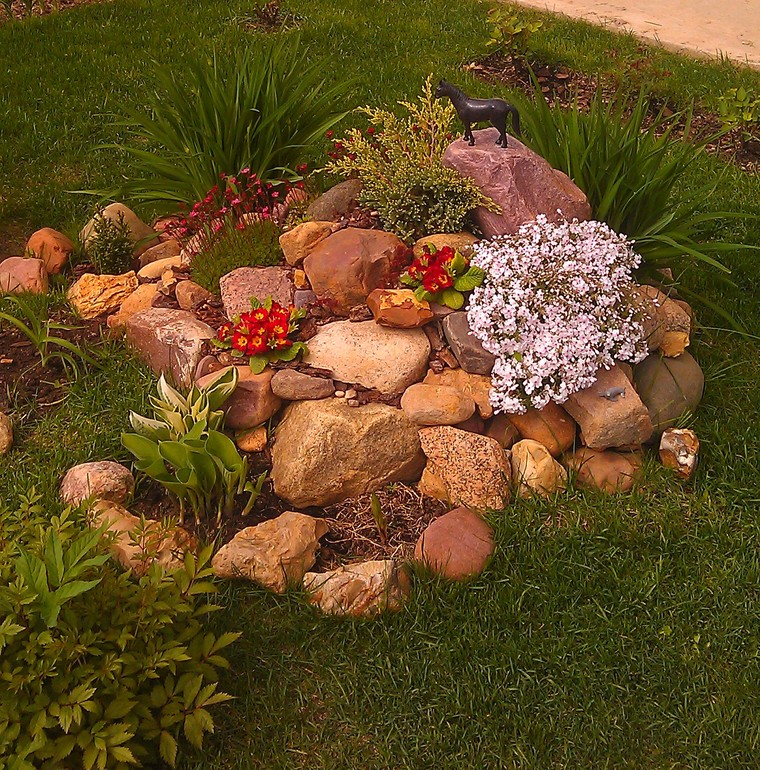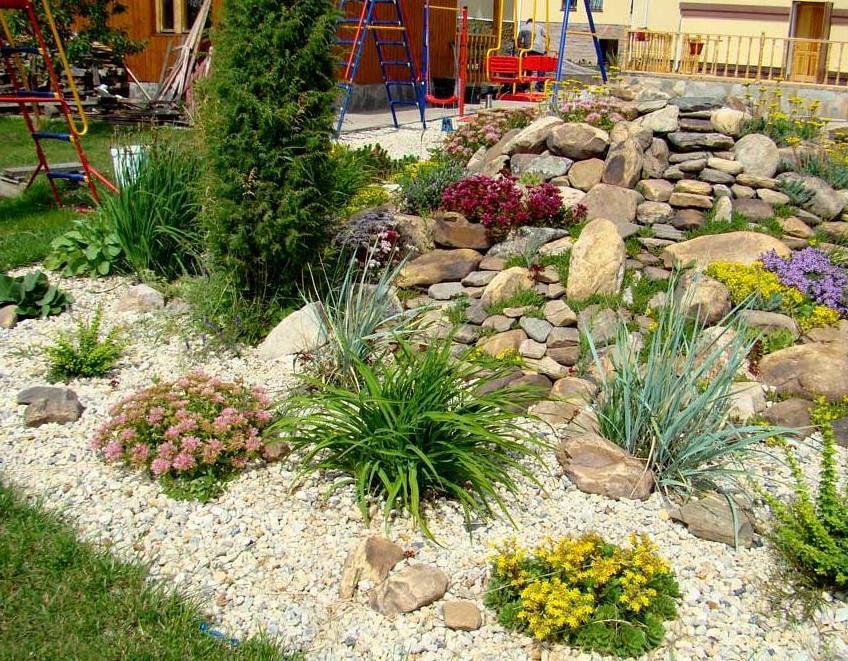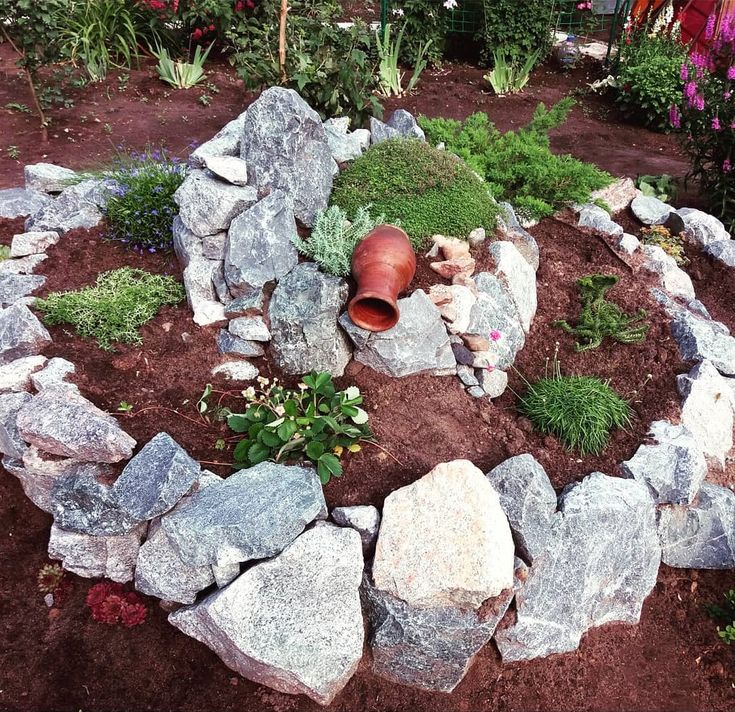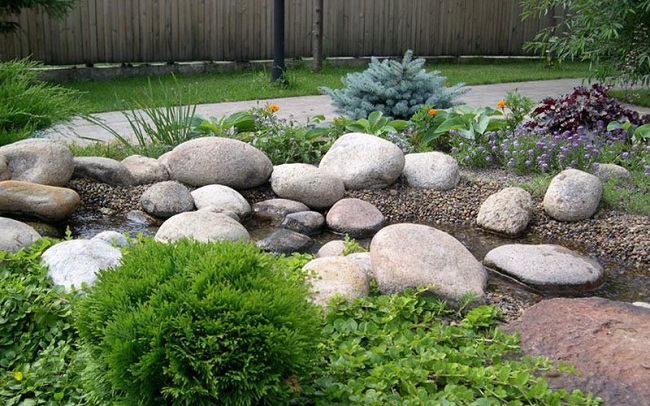Rules for the formation of a plant-stone composition of rockery
Undoubtedly, each person has his own idea of an ideally formed decorative element of a large landscape idea. But in order for the final result to have an attractive appearance and correspond to the declared name, one should adhere to the fundamental principles of composing a composition.
Choosing the best place
The place for creating the decorative composition described in this article can be almost any corner of the personal plot.
- Of course, it is desirable that it be clearly visible, inevitably becoming an object of admiration for everyone who enters the garden.
- If the land plot is large enough, then the rockery should be placed in close proximity to the recreation area.
- Since unpretentious garden dwellers are used to create a stone-plant decoration, rockery is often used to camouflage a "defective" area of the territory. So, for example, an area of accumulation of construction waste will serve as an ideal place. Having done some preparatory work, you can combine (as most gardeners like it) useful with pleasant.
Site preparation
- Most often, on the territory where the rockery is supposed to be located, there is certain vegetation. So that weeds do not disturb the harmony of the stone garden, the top layer of the soil should be removed, thus carrying out a passing remediation of the site.
- Then, in the selected area, large stone objects should be placed, which, in order to make the composition natural, must be buried in the ground by one third.
- On the vacated area with large stones installed, a mulching material is lined, on which plant objects will subsequently be placed, as well as a layer of pebble of the required fraction.
Placing and planting plants
Planting plants when creating any type of rockery has a clear sequence, the observance of which, of course, is not necessary. But in the absence of proper experience, it is still recommended to heed the advice of a landscape designer.
- First of all, stunted conifers should be planted. In this case, in the mulching film, it is necessary to cut out a circle of sufficient diameter for planting. It is not recommended to make an incision with a cross, since such a technique can lead to spontaneous rupture of the litter along the path specified by the knife.
- Then dwarf deciduous shrubs are planted, which will accompany the conifers. When creating a European rockery, you can use barberries, speria, Potentilla. Low-growing rhododendrons will allow you to add paints. The Chinese lilac looks great, the height of which, unlike its classic counterpart, does not exceed 1 m.
- And to complement the plant ensemble will allow perennial flowers. In this case, you should choose the types that correspond to the location of the stone garden. And since rockeries are most often formed in shaded areas of the backyard, it is recommended to plant shade-tolerant perennials here.
- A variety of ground cover plants, which are often used in the formation of rock gardens, will help balance the composition.
At the end of planting, a small layer of soil is poured onto the mulching material, which is necessary for plants with an undeveloped root system, typical for representatives of mountainous areas, including ground cover.
What styles are there?
Rockery in the garden resembles a rock garden in appearance: the compositions of both elements are formed from stones and plants. A distinctive feature between them is the relief arrangement and the choice of plants for the composition.Rock gardens are located on the natural slopes of the site, and for creating compositions, the choice is limited exclusively to alpine plants.
As a site for the creation of rockeries, absolutely any landscape of the area is suitable, including absolutely flat ground
The choice of plants for rockeries is extensive: in creating a composition, you can use both evergreen conifers, as well as flowering annuals.
Regardless of the style in which the flower garden on the stones will be made, the rockery planting pattern will be approximately similar
Landscape designers distinguish between three main styles of rockeries: English, Japanese, and European. The difference between them is mainly based on the ratio of the number of stones and planted plants.
The English style assumes the use of durable conifers in the composition. Evergreen perennials are loved by the British because they allow you to create landscape decorations that are ready to last for more than one decade.
The European style provides for the creation of stone compositions, which, in terms of filling and composition, are as close as possible to the natural conditions of the middle zone.
In the Japanese style, the emphasis is on stones: the slides are replete with granite blocks, occasionally decorated with bright strokes of a variety of plants
Plant selection
The second constituent element of a stone garden is plants. Their choice also has its own rules.
To begin with, sketch on paper an approximate scheme for planting plants, where what elements will be located, choose the location to your liking, or take one of the ready-made schemes on the Internet.
Plants should be short and slow growing.
If you choose plants with bright flowers and large leaves, they will distract attention from the stones. And the goal of rockeries is to get pleasure from the contemplation of stones.
It is necessary to choose plants in which foliage and stems do not die off for a long time. Faded and yellowed greenery on the stones looks ugly.
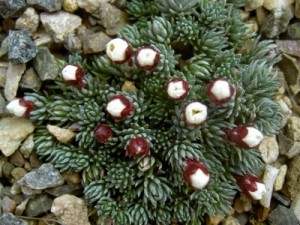
Saxifrage among stones
Most often stonecrops, saxifrage and other rocks growing on rocks are chosen for rockeries.
When planting them, you need to take into account that a 10-centimeter layer of soil is enough for them. For undersized coniferous and deciduous shrubs - 40 cm. And for such an interesting plant, as young, a small handful of earth laid between the stones is enough. Dwarf thuja, microbiota, dwarf junipers will be a good basis for rockery from conifers.
When planting, the moisture content of the plant should be taken into account. If it loves the sun and is drought-resistant, then it needs to take a place higher, and those who love shade and moisture - lower.
The rock breed also dictates its own conditions when choosing a plant. Since some types of stones alkalinize the soil (limestone, sandstones, marble), then the vegetation should be chosen such that such a soil will suit. Granite and volcanic lava acidify it.
Most undersized plants are very fond of the sun, therefore, if there are most of them, rockeries should be placed in a well-lit place.
Beautiful examples and options
Unusual design finds for the device of rockeries are countless. For example, a rocky composition with exclusively mountain plants - lavender, mosses, ferns, wild primroses - looks very natural not far from the house. Its discreet range emphasizes the natural style of the chalet or any of the village trends - country, Provence, rustic.
You can use any elements to visually divide the slide into mini-zones and try to arrange their own season in each thanks to the selection of colors - gentle (spring), rich (summer), golden and purple (early and late autumn).
Some people like to make a solid rocky embankment out of rockery. Not all plants can withstand such "pressure", so the most hardy ones should be selected: saxifrage, ground cover, rejuvenated.
The originals will definitely try to create a rockery wall.A vertically rebuilt stone composition will require a lot of effort, but entwined with clematis, ivy, and peas will turn out to be a real design masterpiece.
Innovative hacienda owners love to mix styles in filling rockeries. For example, European with Italian. It turns out an incredible masquerade of colors from lush, fragrant flowers: crimson, white, fiery, blue.
A 3D artistic volumetric version is considered very fashionable, when designers achieve a circular view of rockery with a varied effect. It is interesting to have it by the gazebo, considering it from different points.
Japanese mini-garden leaves no one indifferent, where stones dominate over tiny plants - mainly fragrant weaving herbs, which causes an extraordinary pacification.
An amazing corner will give you many pleasant minutes, and after creation it will not require too much trouble. According to your mood, you can change its details in some way, bring fresh notes. Once you try on the creative role of a landscape designer, you can hardly give up such aesthetic pleasure later.
The diagrams and step-by-step guidance from the experts that you studied in this article will help you make your dream rockery and get real pleasure in the process of creating it.
For information on how to make a rockery with your own hands, see the next video.
Do-it-yourself rockery: where to start
It should be noted that there are many styles of rockeries. Which one is right for you depends on the overall landscape and your preferences. The main difference lies in the relief placement, the choice of plants and stones. As for plants, the variety for rockeries is great: it can be undersized conifers or bushes, as well as any annual flowers.
To make a rockery with your own hands, it is important to pay attention to finding stones that should be of rough rock: large boulders to create an accent, and small ones to fill in the voids. Experts advise purchasing raw stones, as they retain beautiful shapes, excellent texture and pattern.
Consider the step-by-step process of creating a rockery at a summer cottage.
Stage 1. First, you need to thoroughly study the landscape design of the territory and roughly outline the future location of the composition. The aesthetics and harmony of the entire site depends on the correct choice of place. Ideally, this should be uneven, hilly terrain.
This also includes measuring the site and marking it out. It is advisable to use a cord for this, which is stretched along the entire perimeter. To make your rockery stand out noticeably, there are a few more things to consider:
- It is recommended to abandon darkened areas on which some flowers or fruit trees are already growing. The best and most organic solution is a bright area, devoid of any vegetation.
- If rockeries are located on a slope, it is better not to choose the north side, as this will negatively affect the growth of flowers.
- Before starting work, the entire surface soil layer is removed by a few centimeters. This procedure is necessary to create a good drainage system, consisting of coarse gravel and sand.
The last point is one of the most important. The drainage system will securely hold the entire composition, preventing it from falling apart. This often happens as a result of the peculiarities of the composition of the soil, especially if it is highly clayey. Once the drain is laid, you can proceed to the next stage.
Stage 2. Now is the time to lay out the stones. This should be done in the following order: first, huge blocks, if necessary, pouring sand under them for stability, and then small stones to form a beautiful slide. Those gaps that cannot be covered with a stone can be covered with earth.
Stage 3. Selection of plants.Since rockeries will become the face of your site, you need to select plants so that they smoothly replace each other. For example, immediately after the snow, you can plant snowdrops or crocuses that will decorate the area with bright colors. After them, you can plant tulips or primroses, and with the arrival of the summer period, it will be time for bright and blooming phloxes, sunflowers, cat legs, etc.
Do not forget to also dilute your rockery with conifers, which not only perfectly combine with the stone, but will delight you with their pleasant aroma.
So, to create a rockery in the country with your own hands does not require a lot of effort and money. The main thing is to use your imagination and not be afraid to experiment.
Plants for rockeries
To create a harmonious composition in a rockery device, the correct selection of plants is no less important than the selection of stones. To plant the plants between the stones, you should fill in the soil suitable for the selected species.
If your rockery is small, its composition should still be analogous to a real rockery, only in appropriate proportions. Superdwarf plants will help in this, these are juniper, thuja, spruce, and also rejuvenated, saxifrage, sedum and some ground covers.
In a larger rockery, you can pick up plants from a wider spectrum. In addition to those plants that are classified as alpine, you can also plant those that will harmonize well with the composition as a whole. They will complement each other, and your rockery will delight the eye all year round.
The creation of a rockery is a process where experience is most important. Theoretical knowledge, however fundamental it may be, will not give you a guarantee of error protection. And experience comes with time, when you learn in practice the capabilities and needs of plants. Therefore, for your first rockery, opt for perennial plants that do not require complex agrotechnical care, you should not immediately strive to plant exotic plants, they will become capricious in an unusual climate, and you will not be able to help them. Plants with irregular leaf color and interesting shape always look beautiful between stones. In early spring, immediately after the snow, these are snowdrops and crocuses, and later, undersized tulips, muscari, primroses.
The main ones in rockeries will be ground covers - a cat's paw, tenacious, sunflower, saxifrage, yaskolka, thorny phlox, evergreen Iberis - they will be located in rockeries with rugs and pads. Azure blotches will give thin-leaved fescue, and purple will add geyher.
Conifers are indispensable in rockeries - cushion and pyramidal spruces, cypresses and dwarf thuja, junipers, microbiota.
There are countless options for creating rockeries, the choice and placement of plants play an important role. The main thing is to achieve a harmonious and natural look, to avoid excessive diversity, and then the rockery will become your favorite vacation spot, your pride, will delight you and your guests all year round.
Main works
As an example, we will consider the creation of a microscopic rockery, but by analogy, you can create something more voluminous.
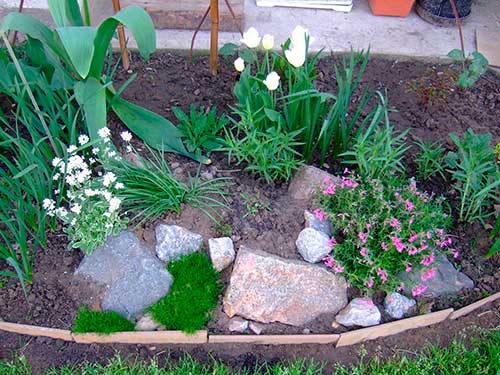
First of all, you need to properly prepare the base. The contour of the future rockery can be marked on the site using a cord (attach it to the ground with long nails or tie it to pegs) or small stones.
Foundation preparation stages:
Step 1: the sod and the topsoil are cut to a depth of 20 - 25 cm;

Step 2: the soil is sorted out (weed roots should be removed from it), if necessary, it is treated with a herbicide);
Step 3: Drainage geotextiles can be laid on the base, it prevents the germination of weeds;

Step 4: if the activity of moles or shrews is noticed on the site, the base is closed with a metal fine-mesh mesh with an anti-corrosion coating;
Step 5: if the site is not located on a hill, from which water quickly leaves, and the base soil is "heavy", poorly permeable to moisture, equip drainage - lay a layer of rubble or broken brick, pour a layer of coarse sand 5 cm thick on top;

Step 6: Cover the prepared area with soil.

The soil for rockeries should not be overly fertile so that the plants do not grow too quickly during the season. It is best to lay in layers (from bottom to top) loam, black peat, garden compost, meadow or forest land. If the plants do not have enough nutrients (focus on their appearance), replace the top layer with black soil.
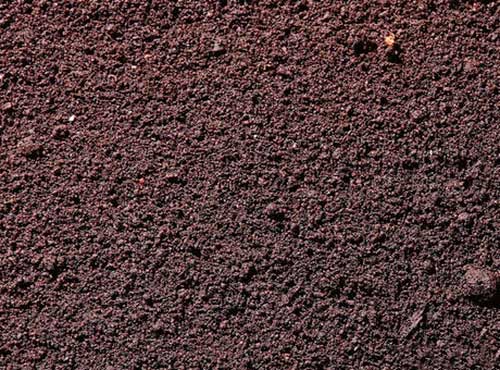
Freshly filled soil (initially, the "pillow" should rise above the surface of the site) should settle well, for this, water the future rockery daily for at least two weeks.
The next stage is the laying of large stones. Pick up boulders of the same texture - either an angular, embossed wild stone, or round blocks cut by water (such a rockery is combined with an artificial reservoir). Boulders should not hide behind overgrown plants in the future, because are a key part of rockeries. To prevent the stones from settling, dig depressions under them and make a "pillow" of gravel and sand. The boulders must be stable.

Leave space for planting, the remaining space "pave" with tiles of relief wild stone, pebbles or colored rubble, small stones - depending on the effect you want to achieve.
At the final stage, plant the plants in the ground according to the prepared plan.
It is important to water the rockery daily until the roots of the plants take root.
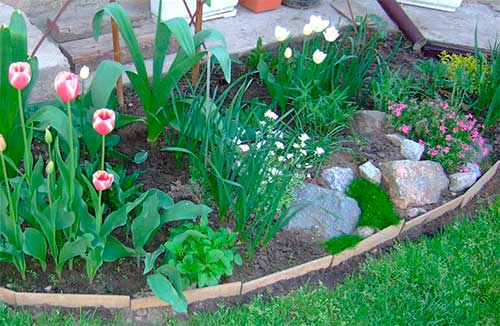
When arranging rockeries, the main thing is taste and a sense of harmony. Visual accents should be balanced, and randomly thrown stones should be avoided, creating the effect of a quarry.
Video on the topic "rockery with your own hands":
Plants for rockeries
Rockery is, first of all, a composition of stones. But you cannot leave it completely without plants - the view will be gloomy and dull. Evergreen conifers, ground cover and perennial flowers, wild grasses in moderation will revive the stones and complete the composition of the natural landscape.
 The process of planting plants in rockeries.
The process of planting plants in rockeries.
Plants for rockeries are selected depending on its type, location and design style. Before planting plants, you need to prepare the soil. For this, the territory of the rockery is covered with a special substrate and compacted. Then it is watered with water and left to settle naturally. After that, you can start planting plants.
On a note! To avoid erosion and subsidence of the soil, the substrate should be poured at least every two years.
 Miscanthus is a popular ornamental grain, perfect for decorating a stone slide.
Miscanthus is a popular ornamental grain, perfect for decorating a stone slide.
First, you need to draw up a detailed plan for planting plants. It all depends on your taste and imagination. The names and photos of plants for rockeries can be found on thematic Internet resources. There you can also see ready-made landscaping schemes for stone gardens.
 Dry stream scheme: 1 - leaf grate bamboo; 2 - hybrids of bearded iris; 3 - lobelia; 4 - creeping tenacious; 5 - Poskharsky's bell; 6 - obriety hybrids; 7 - large-leaved bruner; 8 - styloid bryozoan; 9 - red-leaved creeping tenacious; 10 - reed arundo.
Dry stream scheme: 1 - leaf grate bamboo; 2 - hybrids of bearded iris; 3 - lobelia; 4 - creeping tenacious; 5 - Poskharsky's bell; 6 - obriety hybrids; 7 - large-leaved bruner; 8 - styloid bryozoan; 9 - red-leaved creeping tenacious; 10 - reed arundo.
You should start with planting conifers - the basic plants in rockeries. For this, western and spherical thuja, common or virgin juniper, cypresses, mountain pine and other types of stunted and slow-growing plants are suitable. The rockery of conifers in front of the house will be picturesque (photo options for planting conifers illustrate the optimal placement). It is recommended to plant conifers in autumn or early spring.
 Ephedra are basic plants in rockeries. If you are afraid that the soil on the site is not suitable for conifers, you can arrange rockeries with conifers growing in large decorative pots.
Ephedra are basic plants in rockeries. If you are afraid that the soil on the site is not suitable for conifers, you can arrange rockeries with conifers growing in large decorative pots.
The next step will be the planting of decorative deciduous shrubs. For this, Amur barberry, chubushnik, Japanese spirea, cotoneaster, Potentilla, boxwood, etc. are suitable.
 Opposite-leaved saxifrage is a ground cover plant that is excellent for decorating rockeries.
Opposite-leaved saxifrage is a ground cover plant that is excellent for decorating rockeries.
The last stage of landscaping will be the planting of flowers. To make rockery look spectacular all year round, it is advisable to combine plants with different flowering times
Moderation in colors will be an important point here, so that the flowers do not distract attention from the main element - the stone.
 The chimney is usually placed near large stones, in crevices or on slopes.
The chimney is usually placed near large stones, in crevices or on slopes.
Perennial and ground cover plants for rockeries are varied. It can be primroses, saxifrage, rejuvenated, astilbe, bergenia, subulate phlox, iberis, tenacious. Small-bulbous crocuses, low daffodils, undersized tulips and snowdrops will be the first to decorate rockeries in spring.
 Blooming ground cover plants delight the eye with bright colors and perform a protective function, strengthening the soil.
Blooming ground cover plants delight the eye with bright colors and perform a protective function, strengthening the soil.
Ground cover flowers (geranium, periwinkle, saxifrage, creeping veronica, sedum, hare cabbage) are planted in crevices. In addition to their decorative appearance, they also perform a soil-protective function. The root system of these colors strengthens the soil, which prevents it from eroding. Cereals (fescue, miscanthus, ciliated barley, feather grass) and ferns will give a special kind of "wildness" to rockeries.
 Various types of cacti are used in the design of the horizontal rockery. If you have no experience or desire to care for plants, opt for unpretentious species.
Various types of cacti are used in the design of the horizontal rockery. If you have no experience or desire to care for plants, opt for unpretentious species.
If the composition is based on a stream or a small pond, moisture-loving plants should be planted near them, and those that are more resistant to drought should be placed between the stones. Low-growing bulbous plants like to bask in the sun, so it is better to plant them in well-lit places. Also, when planting plants, it is necessary to take into account the breed of stones used in rockeries, because some of them can oxidize or alkalize the soil.
 The best option for moisture-loving plants is to plant them next to a water source.
The best option for moisture-loving plants is to plant them next to a water source.
Selection and rules for setting stones
When choosing stones, it is also worth knowing a few rules. Not all stones can be suitable for such a structure. They need to be laid according to a certain principle:
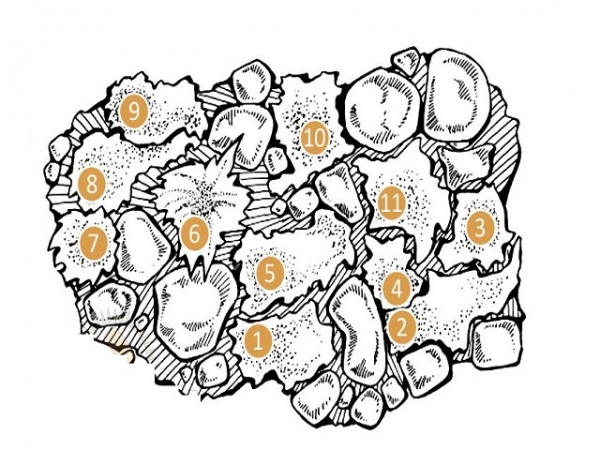
Large stones in rockeries form the basis of the landscape plot, therefore, their choice should be given more attention. It is better to choose 2-3 boulders for this.
The boulders should be stable, not swaying.
Before installing particularly large stones, it may be necessary to concrete the base or add rubble to prevent their subsequent burial into the ground.
Smaller stones are used to create the background of the composition.
It is better to choose the colors of the stones in muted natural tones: beige, yellowish or gray
Against this background, the plants look very impressive.
You should not combine stones of different textures and rocks - it looks extremely inharmonious.
To make the composition look natural, the stones in rockeries must be oriented in one direction.
It is required to leave enough space between the stones for the development of the plant root system.
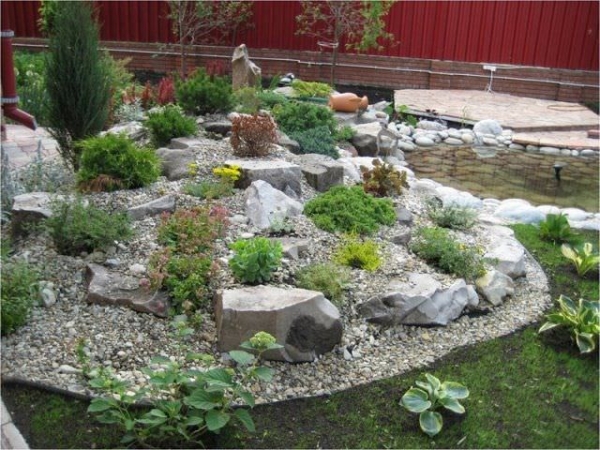
Suitable rock types
When device alpine slide and Rockeries commonly use slate, tuff, limestone, sandstone, and granite.
The most suitable of them for rocky compositions is limestone. It has no sharp corners, is easily weathered and has the appearance of plates that are convenient for use.However, lime, when interacting with the soil, gives an alkaline reaction, this point must be taken into account if you want to plant plants that prefer acidic soils.
Some types of sandstones, on the contrary, can acidify the soil, therefore, after the completion of construction work, it will be useful to measure the acidity of the soil.
Porous tuff looks very impressive in rocky compositions, but weeds that have grown in it are very difficult to remove.
Do-it-yourself rockery in the country: scheme and manufacture
To find out how to make a rockery with your own hands in the garden, we suggest that you familiarize yourself with the step-by-step instructions, where you will also find tips on choosing plants and stones, their placement and "neighborhood" among themselves.
Choosing a place and design. It should be noted right away that rockeries will look much more spectacular if you equip it on an uneven surface or slope. Even the smallest mound can be given for the arrangement of artificially created picturesque cascades, rocky taluses, and ledges. But it can be arranged on a flat surface, however, some efforts should be made here to create the appearance of an elevation.
Preparing the soil. First of all, we remove the top layer of soil (sod) up to about 20 cm. At the bottom we spread a layer of drainage from broken bricks, gravel and rubble. After that, we compact everything with high quality, and also level it with sand. This will allow us to get a sufficiently rigid base for the stones, while it will allow moisture to pass through to nourish the plants that we will plant. Don't forget to make a sanding substrate. It is quite easy to create it, you just need to mix garden soil, fine gravel, brown peat and sand. This mixture is characterized by moisture content and water permeability, which is necessary for the normal development of flowers. The only thing to remember is do not feed the substrate with strong mineral plant baits, as they should develop at their usual pace. Otherwise, they will quickly grow, cover all the stones, which will completely ruin the composition.
We select stones. Remember that they should be natural, soft colors, such as gray, yellow or beige.
Firstly, it will make the rockery "natural", and secondly, the plants on a similar background will look very impressive
It is also important to pay attention to their size. For example, a few large boulders look much better than many small ones, but there are no restrictions on the placement of stones.
Install stones
After you have selected the boulders and delivered them to the place of the future structure, you can proceed with the installation
It should be noted that this stage must be approached very thoroughly, since the whole type of composition will depend on your actions. So, remember that the stones need to be placed in one direction, and the flattest ones are set at a slight angle in a horizontal position. Thus, you will achieve maximum naturalness. Do not forget to leave a small distance between the boulders, where in the future we will plant flowers and plants.
Seating of plants and flowers. Even before planting green crops, your stone garden should look spectacular. Only in this way you will have a 100% guarantee that the composition will be natural and durable. After that, we cover the ground between the boulders with a dense plastic wrap with holes for placing plants in pots or containers. When choosing plants, pay attention to their maximum height, as they should not be taller than the stones around them.
The final stage is finishing work. To do this, you can use crushed stone, gravel chips, river pebbles, with which you need to decorate the space between stones and flowers.
In the photo - do-it-yourself rockery in the garden,
In the photo - do-it-yourself rockery in the garden,
In the photo - do-it-yourself rockery,
In the photo - do-it-yourself rockery,
Photo of rockery,
Photo of rockery,.
In the photo - do-it-yourself rockery in the country,
In the photo - do-it-yourself rockery in the country,
Photo of a rockery made with your own hands,
Photo of rockery made with your own hands,
Photo of rockery in the garden,
Photo of rockery in the garden,
Photo of rockery boulders,
Photo of rockery boulders,
The most common styles of rockeries
Garden compositions consisting of plants and stones are different. However, they all have one thing in common - a beautiful extraordinary appearance and uniqueness. Of course, when breaking rockeries, certain technical rules must be observed, which we will talk about below. But your imagination can be shown as you like, so that the mini-garden is exactly the way you want it to be.

European style. The most versatile option for our country. Perhaps that is why European rockeries are so popular with our compatriots who own suburban areas. Its main feature is rough gray stones and plants that grow in European nature, including Russia. They are distinguished by their unpretentiousness, they feel great in the climate of the middle zone, and after planting they delight with their beauty not a single season. Also, this rockery may include flowers growing wild in the fields and low shrubs, which attract with unusual foliage. Fir trees often decorate rockeries in the European style.
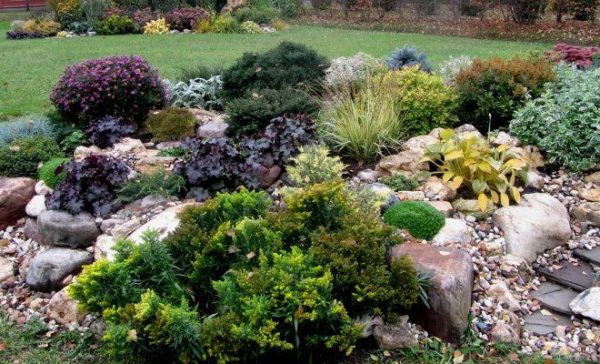 Rockery. European style.
Rockery. European style.
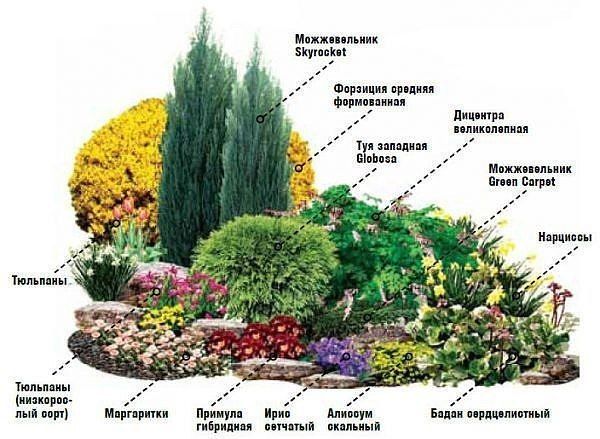
Japanese style. Exotic Japanese rockeries are set up on their sites by admirers of oriental culture and lovers of special sophisticated aesthetics. Here you will not find overly bright colors, tall trees and other contrasts inherent in the European style. Only a lot of stones (mostly granite) of various shapes and sizes, and small neat shrubs dotted throughout the rockery area. Often figures are laid out of stones here. Japanese rockery goes very well with a small pond. It can also be decorated with additional figurines and lighting.


English style. The name of this rockery speaks for itself. The English style is a classic that is characterized by restraint, rigor and durability. Most often, these mini-gardens are decorated with bright perennial plants, a small rocky embankment and lawn grass. But flowers in English rockery are rare. The main emphasis here is on the greens.
 Rockery. English style. Another popular variety of rockeries is the Alpine Hill. As a rule, in the rock garden there are exactly those plants that grow in the real European Alps. This rockery is created on a slide along which the plants go down in a cascade.
Rockery. English style. Another popular variety of rockeries is the Alpine Hill. As a rule, in the rock garden there are exactly those plants that grow in the real European Alps. This rockery is created on a slide along which the plants go down in a cascade.
Independent rockery device - mistakes
The place for creating rockeries must be chosen correctly, it is not chosen randomly or in any convenient place. Rockery should blend harmoniously with the relief, the combination of retaining walls, elevation differences in the surface, a stream or an artificial pond should look natural. Any buildings or a fence will violate the harmony of a corner of nature. But if you cannot do without a fence or a building wall, then they must be draped with climbing plants or shrubs. If you have chosen a sunny place for rockeries, then you will have more opportunities for selecting plants than for a shady place.
The beauty and naturalness of rockery does not depend on the number of stones scattered in a mess. Each boulder or stone should take its own place, only allotted to it, carefully thought out and emphasizing the harmony of the general appearance of rockeries. Preferred stones from the same material, but different in size. If there are no elevation differences on the site, then smooth boulders will look more natural.
When placing stones, choose a more effective stone surface.Larger stones are placed at the base, sometimes they are even dug into the surface, they become the basis for the composition, and smaller ones emphasize its naturalness. Stones can be held together with glue or a special solution. Avoid using a large number of stones with sharp edges, as this can create an uncomfortable feeling.
Take your time when creating rockeries, this process requires thoughtfulness and a responsible approach.
Soil structure is important. If the soil is loose, it should be compacted, gravel is placed under large stones and boulders, it will prevent subsidence, and will also serve as drainage and relieve your rockery from the accumulation of water.
Sometimes garbage left over from construction is used as drainage, but such experience should not be adopted, the garbage will damage the plants and they will die.
If you want to expand your small rockery, then this can be done using gravel bedding. Be sure to put geotextiles under the dump, it will act as a barrier to the growth of weeds.



